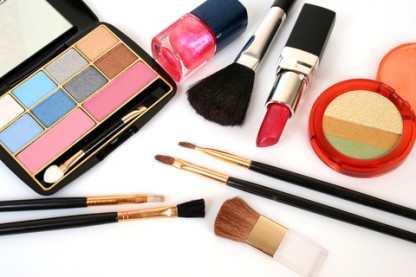Makeup Toxicity: Ingredients to Watch For!
 The truth is that many cosmetics contain potentially toxic ingredients. From heavy metals to endocrine disruptors to carcinogens, there are thousands of chemicals used in makeup that may be harming your health. This article will discuss some of the worst, most-maligned toxic makeup ingredients and what you can do to protect yourself from makeup toxicity while you’re enhancing your beauty with cosmetics.
The truth is that many cosmetics contain potentially toxic ingredients. From heavy metals to endocrine disruptors to carcinogens, there are thousands of chemicals used in makeup that may be harming your health. This article will discuss some of the worst, most-maligned toxic makeup ingredients and what you can do to protect yourself from makeup toxicity while you’re enhancing your beauty with cosmetics.
The federal Food and Drug Administration (FDA) exercises very little power over the ingredients used in makeup
Cosmetics are not approved by any regulatory agency before they go on the market and toxic makeup ingredients do not have to be listed on cosmetics ingredient labels. The agency admits on its website that it does not have the legal authority to approve cosmetics before they go on the market and that cosmetic companies may use almost any ingredient they choose. The FDA’s lax oversight of cosmetics means you need to do your own research and act on your own to protect yourself.
Formaldehyde releasing ingredients in makeup
Many of the toxic makeup ingredients that have been linked to cancer and reproductive health problems are included as preservatives. Nearly 1 in 5 cosmetic products contains a substance that generates formaldehyde, a known carcinogen and potent allergen, according to FDA data.[5] Quaternium-15 and DMDM hydantoin, for example, are two preservatives that slowly release formaldehyde in order to prolong cosmetics’ shelf-life. Called “formaldehyde releasers,” these chemicals are commonly used by some of the world’s biggest cosmetic companies because they decompose slowly over time to form molecules of formaldehyde, acting like time-release capsules to maintain a fairly constant level of preservative in the makeup.
Parabens in makeup
Another commonly used group of preservatives by giant cosmetic companies like Revlon and L’Oreal is the long-chain parabens. While they may lengthen your makeup’s shelf-life, some long-chain parabens are endocrine-disruptors—that is, they interfere with hormones that regulate numerous body processes, including the reproductive system. Studies indicate they can mimic the hormone estrogen and are linked to an increased risk of breast cancer.[1]
Phthalates in makeup
Phthalates, a group of plasticizers, are another group of toxic makeup ingredients. These dangerous substances are lumped together in the ingredients list under the vague term “fragrance.” Phthalates are endocrine disruptors and may increase the risk of breast cancer.[3] In 2005, scientists at the University of Rochester reported that prenatal exposure to phthalates was linked to abnormal reproductive development in baby boys.
Heavy metals and makeup toxicity
In addition to formaldehyde-releasing preservativesand endocrine disruptors like phthalates and parabens, your makeup likely contains toxic heavy metals like lead and mercury. The FDA rules permit a small amount of mercury, a powerful neurotoxin, to be used as a preservative in mascara and other eye area cosmetics. While there has been surprisingly little research done to learn about the health effects of chronic, low-dose mercury exposure, many health experts believe even low levels of mercury may cause health problems. They are especially concerned about mercury’s role in causing nervous system disorders such as Alzheimer’s, multiple sclerosis, and depression.[2]
Many lipsticks contain the toxic heavy metal, lead.[4] Like mercury, lead is a proven neurotoxin and no amount of lead in the body is considered safe. Lead can cause learning, language and behavioral problems such as lowered IQ, reduced school performance and increased aggression. Pregnant women and young children are particularly vulnerable to lead exposure, because lead easily crosses the placenta and enters the fetal brain where it can interfere with normal development. The FDA has yet to set a maximum limit of lead in lipstick. Unfortunately, because lead is a contaminant rather than an added ingredient, you won’t find it listed on ingredient labels.
Makeup toxicity: ingredients to watch for
If you don’t want makeup that contains toxic ingredients, you can play detective and scrutinize the product label. Not all ingredients, unfortunately, are clearly listed. And descriptions such as “hypoallergenic” or “natural” can mean anything or nothing at all. Even products with “organic” on the label can contain petrochemicals and as little as 10 percent organic ingredients by weight or volume, according to the Environmental Working Group. Nevertheless, you are still much better off if you learn to read labels. Try to avoid using makeup that contains any of the following harmful chemicals:
1. Fragrances and phthalates:
- “Fragrance” (listed as an ingredient)
- Diethyl phthalate
- Dibutyl phthalate (nail polish)
- Lilial (butylphenylmethylpropanal)
2. Formaldehyde-releasing chemicals:
- DMDM hydantoin
- Imidazolidinyl urea
- Diazolidinyl urea
- Quaternium-15
- Bronopol (2-bromo-2-nitropropane-1,3-diol )
- 5-Bromo-5-nitro-1,3-dioxane
- Hydroxymethylglycinate
3. Parabens:
- Propyl-
- Isopropyl-
- Butyl-
- Isobutyl-
4. Mercury:
- Thimerosal
- Thiomersal
- Elicide
- Ethyl (2-Mercaptobenzoato-S) mercury
- Sodium ethylmercurithiosalicylate
How to choose safe, toxin-free makeup
With the lack of regulation, misleading labeling, and confusing chemical terms, how do you choose toxin-free makeup? One way is to take advantage of the Environmental Working Group’s database of cosmetics and personal care products, called Skin Deep. They give safety ratings and health information for thousands of products and ingredients. Some of the most pure, toxin-free makeup brands reviewed on the Environmental Working Group’s site include Coastal Classic Creations, Jane Iredale, Rejuva Minerals, and Afterglow Cosmetics. Your makeup should not compromise your health. No beauty-enhancement is worth that. Instead, opt for makeup free of toxins. Your face and your body will thank you for it!


 Ask the EN Experts March 2025
Ask the EN Experts March 2025  Vegan Diet Better Than Omnivore Diet for Cardiovascular Health
Vegan Diet Better Than Omnivore Diet for Cardiovascular Health 